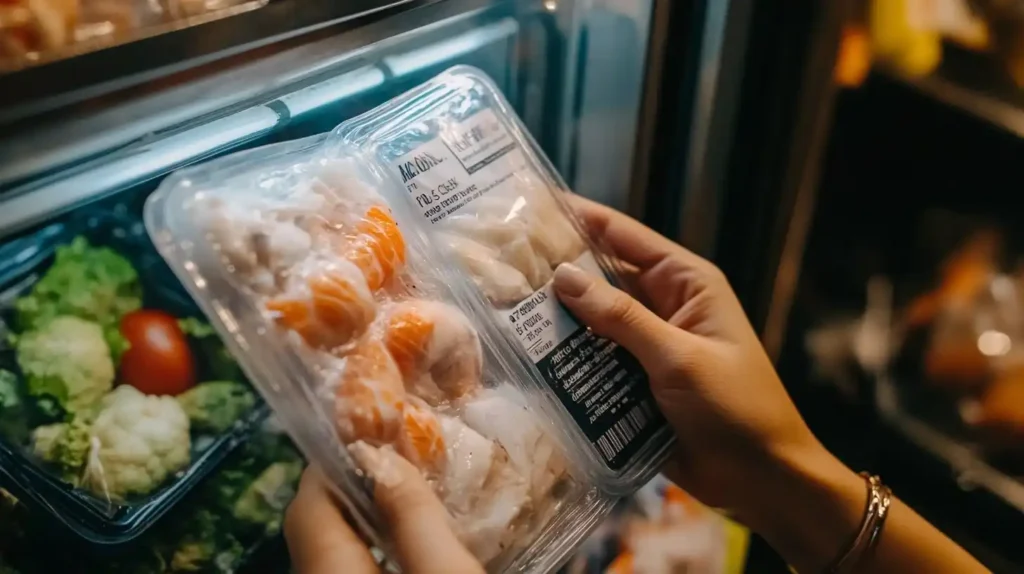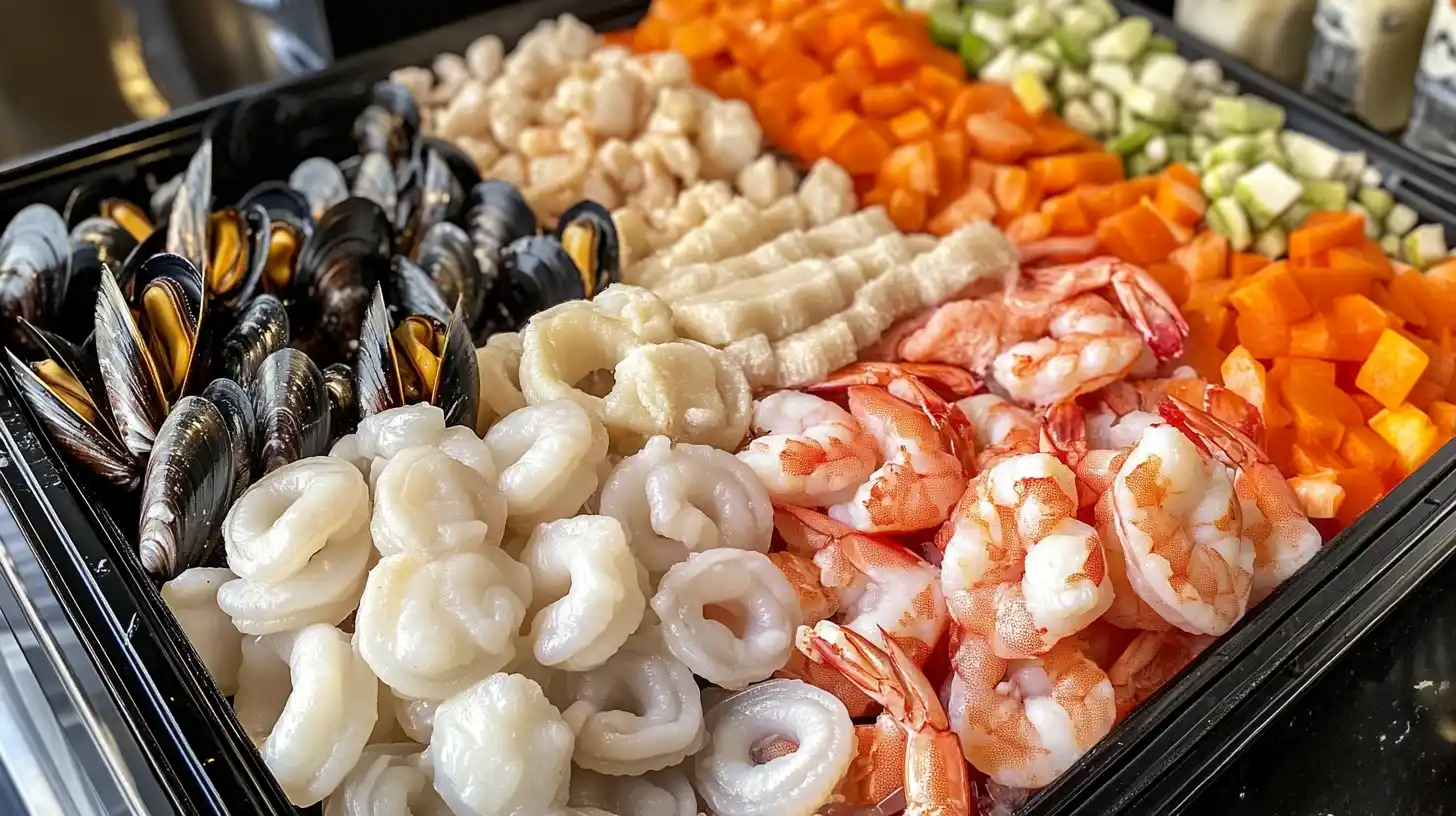Is frozen seafood mix healthy? Many people wonder whether frozen seafood mix is as nutritious as fresh seafood. With seafood being a great source of protein, omega-3 fatty acids, and essential vitamins, it is important to understand if freezing affects its benefits. This article explores the nutrition, benefits, risks, and cooking methods to answer the question: Is frozen seafood mix healthy?
In this article, we will explore:
- What frozen seafood mix is
- Its nutritional value
- Health benefits of consuming it
- Potential risks and concerns
- How to select the best quality
- Proper storage and cooking methods
By the end, you’ll know whether frozen seafood mix is a smart and healthy choice for your diet.
What Is Frozen Seafood Mix?
A frozen seafood mix is a pre-packaged selection of different seafood types, commonly including:
- Shrimp – High in protein and low in fat
- Calamari rings – Good source of protein and minerals
- Mussels – Rich in iron, zinc, and omega-3s
- Scallops – Low in fat, high in vitamins and minerals
- Imitation crab – Made from fish, often used in salads and sushi

For a detailed breakdown of what makes up a seafood mix, check out this guide on what is in the seafood mix.
How Is Frozen Seafood Mix Processed?
After being harvested, seafood is flash-frozen to maintain freshness and texture. Flash freezing is a process where seafood is rapidly frozen at extremely low temperatures, which helps to:
- Lock in nutrients
- Prevent bacterial growth
- Preserve texture and flavor
According to the FDA, properly frozen seafood retains most of its nutritional value and is safe to eat. In fact, frozen seafood is often safer than fresh because freezing kills parasites and bacteria.
Why Choose Frozen Over Fresh Seafood?
Frozen seafood mix is:
- More convenient – It’s ready to cook anytime, no need to rush to the market
- More affordable – Costs less than fresh seafood, especially in non-coastal areas
- Safer – Freezing reduces bacteria and spoilage risks
- Longer shelf life – Stays fresh for months in the freezer
Nutritional Value of Frozen Seafood Mix
When asking, “Is frozen seafood mix healthy?”, one of the biggest concerns is nutrient loss due to freezing. However, studies show that frozen seafood retains most of its nutrients, including protein, omega-3 fatty acids, and essential minerals like selenium and iodine.
1. Macronutrients
- High in Protein – Essential for muscle growth, tissue repair, and metabolism
- Healthy Fats (Omega-3s) – Helps reduce inflammation, improve heart health, and support brain function
- Low in Carbohydrates – Most frozen seafood mixes contain little to no carbs, making them ideal for low-carb and keto diets
2. Micronutrients
- Vitamin B12 – Important for nerve function and red blood cell production
- Vitamin D – Supports bone health, immune function, and calcium absorption
- Iodine & Selenium – Essential for thyroid function and metabolism
- Zinc & Iron – Important for immune health and energy production
3. Does Freezing Affect Nutrients?
A common concern is whether freezing reduces nutritional value. Here’s the truth:
- Most vitamins and minerals remain intact
- Protein and omega-3 fatty acids are not affected
- Water-soluble vitamins (like Vitamin C) may slightly decrease over time

How Does Frozen Seafood Compare to Fresh?
| Feature | Frozen Seafood | Fresh Seafood |
|---|---|---|
| Nutritional Value | Very high (almost the same as fresh) | Slightly higher in some cases |
| Convenience | Long shelf life, easy to store | Must be used quickly |
| Safety | Freezing kills bacteria & parasites | Can contain bacteria if not fresh |
| Cost | More affordable | More expensive |
Frozen seafood preserves most of its nutrients and is just as healthy as fresh seafood in most cases.
Health Benefits of Eating Frozen Seafood Mix
Including frozen seafood mix in your diet provides several health benefits.
1. Supports Heart Health
- Rich in omega-3 fatty acids, which help lower blood pressure and reduce the risk of heart disease
- The American Heart Association recommends eating two servings of seafood per week to improve heart health
2. Boosts Brain Function
- DHA and EPA, two essential omega-3 fatty acids, improve memory, focus, and cognitive function
- Studies suggest that regular seafood consumption reduces the risk of Alzheimer’s and other brain diseases
3. Aids in Weight Management
- High-protein content keeps you full longer, helping with weight control
- Low in unhealthy fats, making it a better alternative to red meat
4. Enhances Immunity
- Rich in selenium, zinc, and vitamin D, all of which strengthen the immune system
Eating seafood regularly can improve heart health, brain function, weight management, and immunity.

Potential Health Risks & Concerns
Including frozen seafood mix in your diet provides several health benefits.
1. Supports Heart Health
- Rich in omega-3 fatty acids, which help lower blood pressure and reduce the risk of heart disease
- The American Heart Association recommends eating two servings of seafood per week to improve heart health
2. Boosts Brain Function
- DHA and EPA, two essential omega-3 fatty acids, improve memory, focus, and cognitive function
- Studies suggest that regular seafood consumption reduces the risk of Alzheimer’s and other brain diseases
3. Aids in Weight Management
- High-protein content keeps you full longer, helping with weight control
- Low in unhealthy fats, making it a better alternative to red meat
4. Enhances Immunity
- Rich in selenium, zinc, and vitamin D, all of which strengthen the immune system
Eating seafood regularly can improve heart health, brain function, weight management, and immunity.
Potential Health Risks & Concerns
While frozen seafood mix is generally safe and healthy, there are some potential concerns to keep in mind.
1. Preservatives & Additives
Some frozen seafood products contain:
- Excess sodium – Used to preserve flavor, but too much sodium can raise blood pressure
- Phosphates – Additives that can affect kidney health in large amounts
- Artificial flavors – Some brands use chemicals to enhance taste
How to avoid this? Always read labels and choose products with minimal additives.
2. Heavy Metal Contamination
Certain seafood types (like shrimp and scallops) may contain traces of mercury and microplastics.
How to reduce this risk?
- Choose seafood with sustainability certifications (MSC, ASC)
- Eat a variety of seafood instead of just one type
3. Foodborne Illnesses
Although freezing kills most bacteria, improper storage can lead to contamination.
Safe handling tips:
- Store seafood at -18°C (0°F) or lower
- Thaw in the refrigerator or cold water – Never at room temperature
- Cook seafood to an internal temperature of 145°F (63°C)
How to Choose a High-Quality Frozen Seafood Mix
Not all frozen seafood mixes are created equal. Some may contain additives, while others might have been stored improperly, affecting taste and quality. Here’s how to select the best option.
1. Check the Label
Reading the packaging carefully can help you avoid unnecessary additives and low-quality seafood. Look for:
- Minimal ingredients – The best seafood mixes contain only seafood, without artificial preservatives.
- No added phosphates – These are sometimes used to retain moisture but can affect kidney health.
- Low sodium content – Some brands use excessive salt to improve flavor and shelf life.
2. Look for Certifications
Certain labels indicate high-quality, responsibly sourced seafood. Look for:
- MSC (Marine Stewardship Council) – Ensures sustainable, wild-caught seafood.
- ASC (Aquaculture Stewardship Council) – Verifies responsible and sustainable farming practices.
- BAP (Best Aquaculture Practices) – Ensures safe and ethical seafood farming.
3. Inspect Packaging for Quality
The condition of the packaging tells a lot about the seafood inside.
- Avoid damaged or torn packages – This may indicate exposure to air, leading to freezer burn.
- Watch out for large ice crystals – These can mean the seafood was thawed and refrozen, which affects texture and taste.
- Ensure the seafood pieces are separate – If they are clumped together, they may have thawed at some point.
4. Choose Flash-Frozen Seafood
Flash-freezing preserves seafood at its peak freshness and maintains texture and flavor. Brands that use flash-freezing often state this on their packaging.
By selecting high-quality frozen seafood, you can ensure you’re getting a fresh, nutritious, and safe product.
How to Choose a High-Quality Frozen Seafood Mix
Not all frozen seafood mixes are created equal. Some may contain additives, while others might have been stored improperly, affecting taste and quality. Here’s how to select the best option.
1. Check the Label
Reading the packaging carefully can help you avoid unnecessary additives and low-quality seafood. Look for:
- Minimal ingredients – The best seafood mixes contain only seafood, without artificial preservatives.
- No added phosphates – These are sometimes used to retain moisture but can affect kidney health.
- Low sodium content – Some brands use excessive salt to improve flavor and shelf life.
2. Look for Certifications
Certain labels indicate high-quality, responsibly sourced seafood. Look for:
- MSC (Marine Stewardship Council) – Ensures sustainable, wild-caught seafood.
- ASC (Aquaculture Stewardship Council) – Verifies responsible and sustainable farming practices.
- BAP (Best Aquaculture Practices) – Ensures safe and ethical seafood farming.
3. Inspect Packaging for Quality
The condition of the packaging tells a lot about the seafood inside.
- Avoid damaged or torn packages – This may indicate exposure to air, leading to freezer burn.
- Watch out for large ice crystals – These can mean the seafood was thawed and refrozen, which affects texture and taste.
- Ensure the seafood pieces are separate – If they are clumped together, they may have thawed at some point.
4. Choose Flash-Frozen Seafood
Flash-freezing preserves seafood at its peak freshness and maintains texture and flavor. Brands that use flash-freezing often state this on their packaging.
By selecting high-quality frozen seafood, you can ensure you’re getting a fresh, nutritious, and safe product.
Best Practices for Storing & Thawing Frozen Seafood Mix
Proper storage and thawing methods ensure that frozen seafood mix stays fresh, safe, and nutritious. Incorrect handling can lead to spoilage, loss of flavor, or even foodborne illnesses.
1. How to Store Frozen Seafood Mix
- Keep the temperature at -18°C (0°F) or lower – This prevents bacteria growth and maintains seafood quality.
- Store in airtight packaging – If the original packaging is open or damaged, transfer the seafood to a sealed freezer bag or container to prevent freezer burn.
- Do not refreeze after thawing – Once seafood has been thawed, refreezing it can cause texture changes and reduce its quality.
- Use within recommended time – While frozen seafood can last for months, it’s best to consume it within 3 to 6 months for the best taste and texture.
2. How to Thaw Frozen Seafood Mix Safely
Thawing seafood the right way is important for food safety. Here are the best methods:
Refrigerator Method (Best Option)
- Place the seafood in a bowl or plate and leave it in the refrigerator overnight (8–12 hours).
- This method maintains quality and prevents bacterial growth.
Cold Water Method (Faster Option)
- Place the seafood in a sealed plastic bag and submerge it in cold water for 30 minutes.
- Refresh the water every 10 minutes to maintain a cold temperature.
- Do not use warm or hot water, as it can cause bacteria growth.
Microwave Method (Not Recommended)
- Some microwaves have a defrost setting, but this can result in uneven thawing, leading to texture loss.
- If you must use this method, cook the seafood immediately after thawing.
Thawing Methods to Avoid
- Do not thaw seafood at room temperature – This can lead to bacteria growth.
- Do not soak seafood in warm or hot water – It can partially cook the seafood, affecting texture and flavor.
Proper storage and thawing methods help maintain the freshness, taste, and nutritional value of your seafood mix.
How to Cook Frozen Seafood Mix for Maximum Nutrition
Cooking frozen seafood mix the right way helps preserve its flavor, texture, and nutrients. Some cooking methods can retain more nutrients than others, ensuring that your frozen seafood mix remains a healthy and delicious option. However, unhealthy cooking techniques may add unnecessary fats and calories, reducing the overall nutritional benefits. Choosing the right preparation method will help you enjoy the best taste and health benefits from your frozen seafood mix.
1. Best Cooking Methods for Frozen Seafood Mix
Steaming (Best for Nutrient Retention)
- Keeps most of the vitamins and minerals intact.
- Preserves the natural flavor of seafood.
- Requires no added fats or oils.
How to steam:
- Boil a pot of water and set a steamer basket on top.
- Add the seafood mix and cover.
- Steam for 5–7 minutes or until fully cooked.
Grilling (Best for Flavor and Texture)
- Gives a smoky flavor with minimal oil.
- Retains protein and omega-3s.
How to grill:
- Preheat the grill to medium heat.
- Lightly brush the seafood with olive oil and season as desired.
- Cook for 2–3 minutes per side or until opaque.
Sautéing (Quick and Healthy Option)
- Uses minimal oil and enhances flavor with garlic, herbs, and spices.
- Great for stir-fries and pasta dishes.
How to sauté:
- Heat a small amount of olive oil or butter in a pan over medium heat.
- Add minced garlic, onions, or herbs for extra flavor.
- Toss in the seafood mix and cook for 5–7 minutes, stirring occasionally.
Baking (Easy and Even Cooking)
- Allows slow, even cooking while retaining moisture.
- Works well with vegetables and light marinades.
How to bake:
- Preheat the oven to 375°F (190°C).
- Place the seafood mix in a baking dish with lemon juice, olive oil, and seasonings.
- Cover with foil and bake for 15–20 minutes.
2. Cooking Methods to Avoid
- Deep-frying – Adds excessive unhealthy fats and calories.
- Overcooking – Seafood can become rubbery and dry if cooked too long.
- Heavy cream sauces – Can add unnecessary saturated fats and calories.
3. Quick & Healthy Recipe Ideas
- Garlic Butter Seafood Stir-Fry – Sauté seafood with garlic, bell peppers, and a splash of lemon juice.
- Spicy Cajun Seafood Mix with Vegetables – Toss seafood with Cajun seasoning and bake with zucchini and cherry tomatoes.
- Lemon Herb Grilled Seafood Platter – Grill seafood with fresh herbs and serve with a light salad.
Cooking seafood mix with healthy methods ensures you get the most nutrients while enjoying delicious meals.
FAQs: People Also Ask
Here are answers to some of the most common questions about frozen seafood mix.
1. Is frozen seafood mix as healthy as fresh seafood?
Frozen seafood mix preserves most of its nutrients, including protein, omega-3 fatty acids, and essential vitamins. Since seafood is flash-frozen shortly after being caught, it stays fresh and safe for longer.
2. Does freezing reduce the nutritional value of seafood?
Minimal nutrient loss occurs. The biggest impact is on water-soluble vitamins like Vitamin C, but key nutrients like protein, omega-3 fatty acids, Vitamin B12, and minerals remain intact.
3. How do you properly cook frozen seafood mix?
The best cooking methods are steaming, grilling, baking, and sautéing. These techniques retain nutrients while adding flavor. Avoid deep-frying or using heavy sauces, as they add unnecessary fats and calories.
4. Can frozen seafood contain harmful preservatives?
Some brands use additives like phosphates and excess sodium to enhance texture and shelf life. Always check the ingredient list and choose seafood with minimal additives and no artificial preservatives.
5. What is the best way to safely thaw frozen seafood?
The refrigerator method is the safest and best way to thaw seafood. You can also use the cold water method to speed up thawing. Never thaw seafood at room temperature, as this can encourage bacterial growth.
6. How long can I store frozen seafood mix?
Frozen seafood mix can last 3–6 months in the freezer when stored at -18°C (0°F) or lower. For optimal taste and texture, consume it within this time frame.
7. Is frozen seafood mix good for weight loss?
Yes! It is high in protein, low in calories, and filling, making it a great option for weight loss. It also contains healthy fats (omega-3s) that support metabolism and overall health.
8. Can I cook frozen seafood mix without thawing?
Yes! You can cook frozen seafood directly by steaming, sautéing, or baking. It may take a little longer to cook, but it’s a convenient option when you’re short on time.
9. What should I look for when buying frozen seafood mix?
- Check the label for sustainability certifications like MSC or ASC.
- Avoid products with excess sodium or phosphates.
- Look for flash-frozen seafood to ensure the best quality.
- Avoid packages with large ice crystals, as this may indicate thawing and refreezing.
10. Can I refreeze seafood after thawing?
It is not recommended to refreeze thawed seafood, as it can affect texture and flavor. If you must refreeze, cook the seafood first before freezing it again.
Frozen seafood mix is a convenient, nutritious, and budget-friendly choice when stored and prepared correctly.
Conclusion: Is Frozen Seafood Mix Healthy?
Yes! Frozen seafood mix is a nutritious, convenient, and budget-friendly alternative to fresh seafood. It retains most of its essential nutrients, including protein, omega-3 fatty acids, vitamins, and minerals, making it an excellent choice for a healthy diet.
While there are some concerns, such as preservatives, heavy metals, and improper storage, these risks can be avoided by choosing high-quality brands, reading labels, and handling seafood properly.
Key Takeaways:
- Frozen seafood mix is just as nutritious as fresh seafood.
- It is rich in protein, omega-3s, and important vitamins like B12 and D.
- Proper storage and thawing methods help maintain quality and safety.
- Healthy cooking methods like steaming, grilling, and sautéing preserve nutrients.
- Choosing high-quality products with sustainability certifications ensures the best taste and health benefits.
By making smart purchasing decisions and using proper cooking techniques, you can enjoy all the health benefits of seafood without worrying about nutrient loss or contamination.

